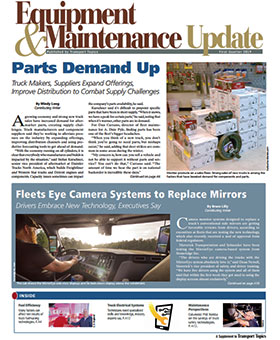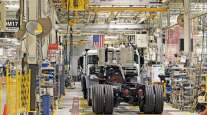The Savings of Truck Safety Technology
As Class 8 trucks grow increasingly complex with safety systems such as collision mitigation, stability control, lane-keeping and the like, is it realistic to think vehicle maintenance costs should not increase?
A recent study reported that per-mile maintenance costs for Class 8 trucks have risen significantly. Over a nine-year period, costs for diesel technicians have increased, as have maintenance costs related to so-called luxury items, which include the above-mentioned safety systems.

Romba
The report, “An Analysis of the Operational Costs of Trucking: 2018 Update,” from the American Transportation Research Institute, tracked maintenance costs from 2009 to 2017. According to ATRI, the average fleet per-mile maintenance cost in 2009 was 12.3 cents. By 2017, fleets reported an average of 16.7 cents.
With that perspective, truck makers and one of the largest fleets in the country said the high-tech systems and specifications on the newest Class 8 tractors may in fact increase maintenance costs. But they said slightly increased maintenance costs should be weighed against safety and operational benefits such as fewer vehicle crashes and injuries.
More than one truck builder recommends a common-sense approach to maintaining these electronic systems.

According to Kurt Swihart, Kenworth’s marketing director, checking radar and camera alignment is important with collision-mitigation systems. Daily checks for debris that would interfere with their operation should be required. Something as simple as knocking a radar sensor out of alignment will increase maintenance costs.
That’s why at Mack Trucks, Scott Barraclough, technology product manager, encourages fleets to fully train drivers on the systems’ operations and components. “We’ve seen instances where drivers accidentally kick the radar unit in the bumper when opening the hood.”
System setup, Barraclough added, also should be fine-tuned to avoid false alerts. Otherwise, he said he is aware of drivers tampering with the system to turn off the alerts.
In addition to having technically advanced safety systems, today’s Class 8 power units have complex systems to reduce engine exhaust emissions.
Art Trahan, senior manager assigned to national accounts for truck leasing and transportation provider Ryder System Inc., said exhaust aftertreatment systems on Class 8 diesel engines were the largest factor behind rising maintenance costs.
Trahan also pointed to a study from American Trucking Associations’ Technology & Maintenance Council, in which fleets reported increased maintenance for aftertreatment have caused higher maintenance costs in recent years. Costs for collision-avoidance, collision-mitigation and similar systems “weren’t as bad as we thought they would be.”
Communication among systems from different suppliers can cause problems, however, Trahan said. “If you keep the systems from the same supplier, there’s one diagnostic routine for the truck and that makes following the fault tree easier to find the cause of a problem.”
Fred Andersky, director of customer solutions — controls at Bendix Commercial Vehicle Systems, said fleets need to consider the “overall value and total cost of ownership of the vehicle,” and that tying higher maintenance costs to the so-called luxury systems is not accurate.
Routine maintenance of brakes and tires helps ensure collision-mitigation and vehicle-stability systems perform as needed, Andersky said. However, “damage to front-mounted radars, such as from rocks, can be costly. But radars have been around for a long time, so costs associated are usually known and factored in for fleets who have used these in the past.”
Fleets must face the fact that the components and systems that make trucks safer — and smarter — will increase maintenance costs. The effect those systems ultimately have on their bottom lines is unknown. But when fleets experience fewer crashes and their related costs, those savings should outweigh any increase in maintenance costs.




